Ok, so this post is not really wedding related. BUT I know for a fact that a lot of my readers are already married, so I have often thought about how to broaden the blog a bit to focus on marriage & happy relationahips in general, just as much as on weddings.
So, while I get busy attempting to figure out how to do that, I am excited to share a really cool lifestyle DIY tutorial today from Kelly Ewell Photography!
DIY Tutorial: How to Make a Custom, Tufted Headboard
[original post here]
Materials:
- your choice of fabric
- plywood
- 2″ foam
- batting
- Sharpie
- ruler
- spray glue
- staple gun
- long upholstery needles
- wax upholstery thread
- washers
- crown molding
- 2×3 wood planks (like 2×4′s but less wide)
- wood stain and brush
- connecting brackets and screws (I’m not sure what these are really called but I’ll show them below)
- patience
What To Do:
1. Measure the width of your bed for how long you want your headboard to be. Now I measured my mattress and took into consideration that the duvet and all adds some width because it’s fluffy. So I maybe added an inch to each side. This was the width I made my plywood.
(As a side note and jumping ahead, I added the wood frame around this so the headboard ended up even wider. I totally didn’t consider that when measuring. Oops. It looked too wide to me, but everyone else said they would have done the same thing. So maybe it’s ok.)
2. So you have your width, and the height it really just subjective. How tall do you want the headboard to come over your mattress? Once you determine that, you’ve got your size.
3. Onto the plywood. I didn’t get one 4′x8′ big sheet and cut it down to size. We got two smaller 2′x4′ pieces. Less cutting and they fit in the car. We bracketed them together, made our measurements, and cut the length. Since our height was 2′, we didn’t even have to cut for that dimension. Now you have your base.
(As a note, the plywood is needed to give the headboard strength. I saw some websites that used peg board since it had all those little holes in it, but it’s way too flimsy in my opinion.)
Click inside for the rest of the step-by-step guidelines and pictures to make a DIY Tufted Fabric Headboard!
4. Let’s move over to the foam. There is 1″, 2″, and 3″ foam. One inch won’t be enough and I read that 3″ is overkill and too cumbersome. I was happy with the 2″. Beware this stuff is more expensive that you’d expect it to be! Really. But the good news was that my piece was also 2′ tall, so it fit our dimensions great that way. I did measure out the length to fit the plywood and just cut off the extra.
5. Now it’s time to space out where you’ll want your tufts. Whip out your Sharpie and ruler and start marking your spots. This is also a subjective part. One thing I’ll recommend is to leave just a bit of extra room along the top, side, and bottom edges. If you’re doing tufts every 5″ or 6″ lets say, then maybe have 6″ or 7″ from your last tuft to the edge. Does that make sense? I hope so! The reason you want to mark these with a Sharpie is because you’ll need something bold and dark to see through the batting later on. I made a lot of mis-marks, so I circled my final tuft spots so I would know which ones to really use.
6. Now it gets a little tricky. You’ve got your marks on your foam, but you need to drill holes in your plywood so that your tufting needle can come through later on. You’ll have to remeasure and remark all your tuft locations onto your plywood. Here’s where it’s handy to have a great husband who will figure out the whole “how do I drill holes into this” part of it. End result, just what I wanted.
7. Spray glue time! You’ll want to spray your plywood really well with glue and then lay your foam over it. Let it set up and dry.
8. Now find your batting and your staple gun. You’ll be wrapping the batting around the foam and stapling it to the back of the plywood. First, lay out the batting over the entire headboard. Start by putting a staple on the back of your headboard in the middle of the top side. Now your batting is set in place and you can continue all along the top putting staples about every 2″-3″. Do the bottom next, then the two sides. Be neat about the corners and pretend you’re wrapping a present to get them pretty and tight. After this step is complete, your headboard will be ready to start tufting! You should be able to faintly see your tuft marks through the batting.
9. This is the real action step and when I really felt things coming together. Like you did with the batting, drape it over your headboard so that it’s evenly spread out. DO NOT STAPLE IT TO THE PLYWOOD LIKE THE BATTING. I’ve seen several, if not more tutorials tell you to do this. I really don’t like the way it looks in the end doing this. The one website I saw that I really liked the tufts kept the fabric loose, so that’s what I did.
(A note about fabric. You’ll want something thicker and sturdy. I wanted velvet, but I was feeling cheap the day I was at the fabric store so I passed on the velvet and instead got a really nice thick brushed cotton off the clearance rack. Point being, don’t get thin quilting cotton or anything like that and nothing stretchy either.)
10. Take your upholstery needle (about 6″ long) and thread through your wax thread. It’s important to use wax thread for a few reasons. One, it’s extra thick and made for stuff like this. Two, the wax will help hold things in place when you’re looking to really tighten your tufts. Before you knot off the thread, add on a washer. Having a washer will help your thread not pull through the holes you drilled in the plywood. Just make sure your washers are bigger than the holes!
11. Time to tuft! Start in the middle to anchor your fabric similar to what you did with the batting. Thread the needle up from the back side of your plywood through the foam. You can peel the fabric back a bit to see if the needle is actually coming up through the center of your tuft mark. It likely will need a bit of trial and error adjusting until it comes right up through the middle. You want to be rather meticulous about this part because you want to keep your tufts in line and equally spaced. You took the time to measure and be precise before, so it’s important to stick with the spots you picked. Once you see the tip of the needle coming through, fold the fabric back over the spot and pull the needle completely through. Now take the needle and send it back down through the fabric (just a small bit away from where it came through the fabric originally), through the foam, and out the back side of the plywood. Getting the needle to find the hole in the plywood also takes some patience and trial and error.
12. You should have enough thread hanging off the back side that you can tie it off. Cut off the needle and thread one end of the thread through the washer (so you have something to knot against). This is where you’ll need just a bit of strength. You need to pull hard enough to get your fabric to tuft down into your foam. I actually had my husband push his finger down into the foam to get me started. Then knot it off. As you do your first tie off, the wax should come in handy to help your tuft stay in place as you knot it off again. One down! Lots more to go, so keep repeating this step until you’re done.
(Something to keep in mind as you’re doing your tufts, is that you want your folds of fabric to go the same direction all the time. Designate a top and a bottom of your headboard, and make sure your folds are folded down towards the bottom).
13. Now it’s time to staple the fabric to the back of the plywood like you did with the batting. What I did was make folds that came straight out to the edge, but some people try to continue the diamond pattern. That seemed harder to me, so I stuck with straight folds and again making them all go in the same direction.
(As a note, I recommend starting on the left of one edge and moving to the right. My first edge I started in the middle again, moved down to the right, and then came back to do the left side. But I noticed that I didn’t have enough room to get my hands under the fabric to do the nice folds. I made it work but it was WAY harder. So start on the left side of an edge and just move along from them. But like the batting, do the top side first. Then the bottom, then the sides. And keep the folds nice and neat on the corners again. This may take some finesse.)
14. YOUR HEADBOARD SHOULD LOOK AWESOME AT THIS POINT! I was doing the happy dance at this point because it actually looked like what I wanted it to. My husband was really impressed too. I showed a sneak peak to friends and they started asking me to do this for them too. Too bad this wouldn’t ship well!
15. Buttons. You may have noticed that we’ve tufted without buttons. Yep, and it’s time to add them now. You can either pick buttons you like or you can go the route I did and get packages of buttons that allow you to cover them with the same fabric that you used on your headboard. Warning, I think the fabric-covered buttons look way better but they’re way annoying to make. Several swear words came out of my mouth and parts were thrown across the room more than once. Husband actually finished up the second half of them for me. (Thank you, honey!)
16. Take your same wax thread and upholstery needle and thread on a similar length as when you were tufting. Knot off the end, without the button. Now take the needle, thread it through the button hook and then through the center of the thread so that it will knot onto itself. I know this sounds confusing just typing it so hopefully the photo will show it better.

17. Instead of coming from the back of the plywood like before, we’re coming from the front. Push the needle through the tuft and hunt again for the hole on the backside. Again, a bit of trial and error and adjusting. When the needle comes through the back again, tie it off on the washer like before. Repeat for all the buttons. And then this part is done!
18. Ok, onto the frame. I have to say, this project stopped being fun at this point and as we progressed I just wanted it to be done. Just fair warning. So let’s start with your molding pieces and measure out how long they should be around your tufted headboard. Remember if you’re just measuring the headboard, that would be your “inside” edge. When you cut the molding, you’ll be doing so on a 45 degree angle out from those measurements so that the pieces can fit together. And because of those angles the final length of the molding will be longer than what you just measured.
19. You’ll need to stain your molding pieces, so do that now according to the stain instructions and let them dry.
20. Now that let’s move onto the 2x3s. You need these because you need something to mount the crown molding onto. We started with 2×4′s, but they were just too wide and would have stuck out past the crown molding. Depending on what you pick, you may even need to get 2×2′s. Measure and cut your 2×3′s to length. Remember that the side pieces need to be long enough to go to the floor so the headboard will stand at the height you want. I made ours so the bottom edge of the tufted part sits right level with the top of our mattress. You will then secure these with longer brackets.
19. We’re so close to the end! Now we have to attach the molding to the 2×3′s. I didn’t want any nail holes, so we used liquid nails to attach the molding to the 2×3′s. I also didn’t really want to the 2×3′s at all, so just in case instead of having the inside edge of the molding line up exactly with the edge of the 2×3, I had it extend just a couple of millimeters. Let them set and dry.
20. The final step is that you have to attach the molding/2×3 combo to the plywood. You’ll likely find that when you were tufting, you created a headboard that’s not completely squared off. Yeah, that was a lovely discovery. So you might have some gaps, especially if your molding is at all bowed. So as we were using longer brackets to attach the 2×3 to the plywood, there may or may not have been some pushing and finessing to see if we could make the gaps smaller in places and to square things up. It helped a little, but not as much as I had hoped.
21. You could throw in the towel and be done, but if you’re a perfectionist like me then you’ve noticed that you can see the 2×3′s on the side and you don’t like that. We got really thin strips of wood, stained those, and liquid nailed those to the sides to make it look more finished. Then we really were done! Whew, what an accomplishment!

Voila!
A special thanks again to Kelly Ewell Photography for sharing this awesome DIY Tutorial! Let us know if you use it and make your own DIY tufted fabric headboard.

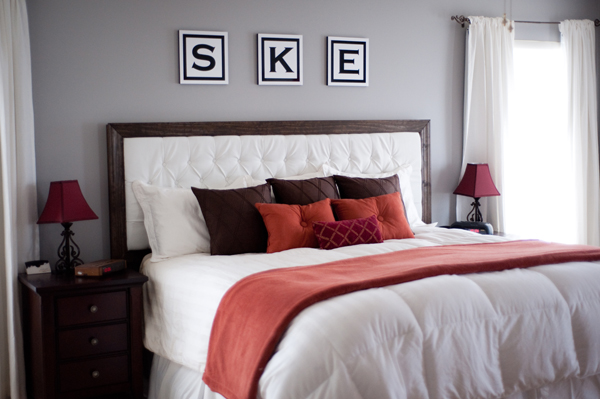
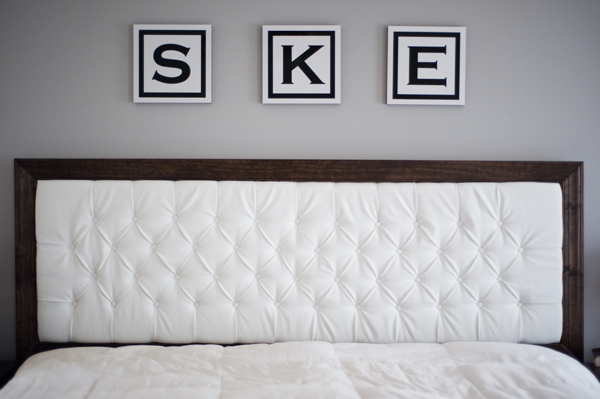
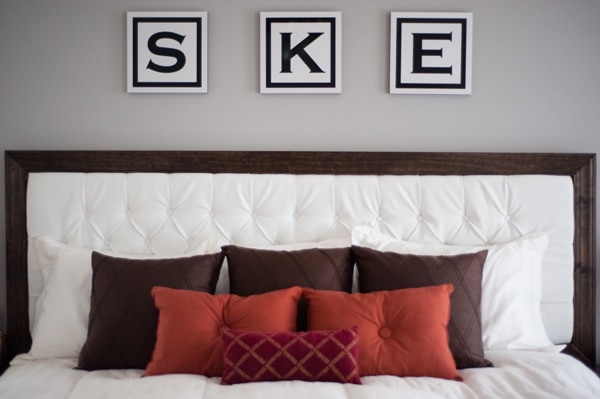
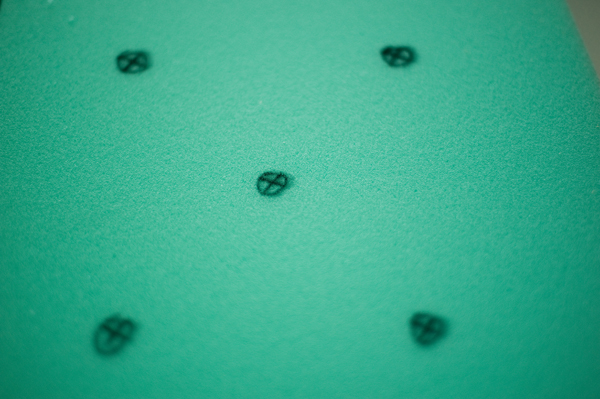
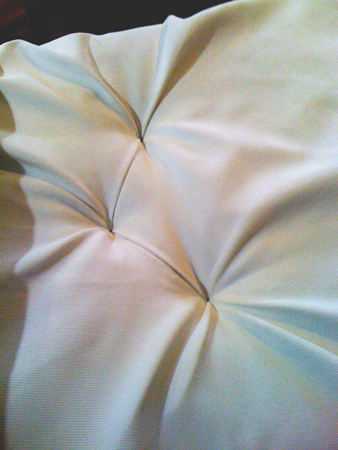

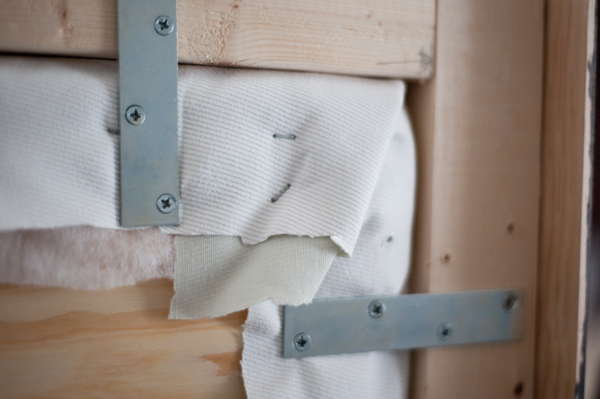
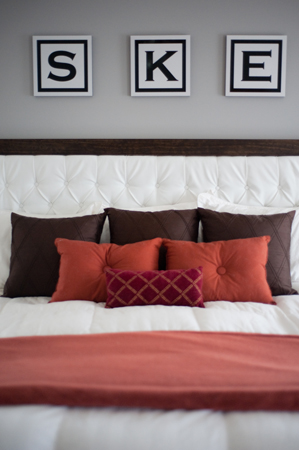
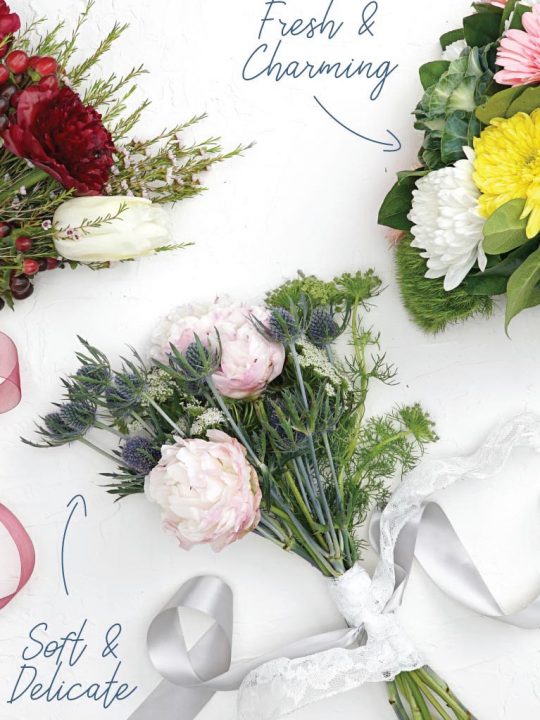
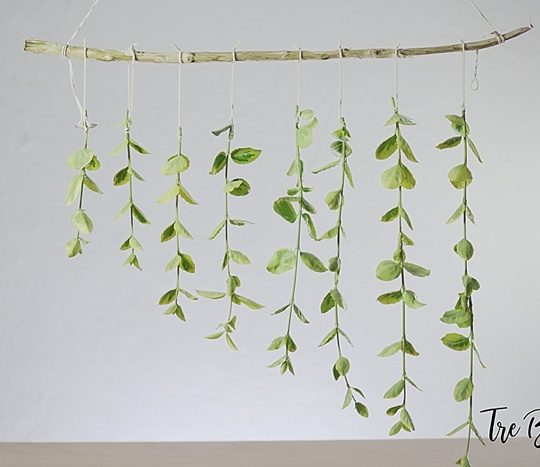
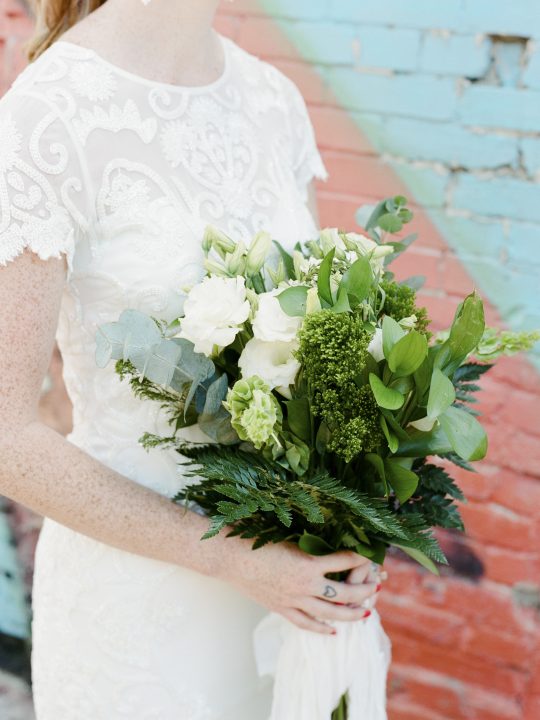
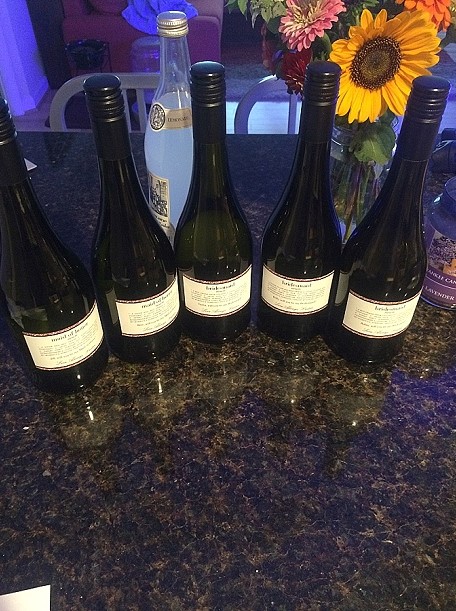
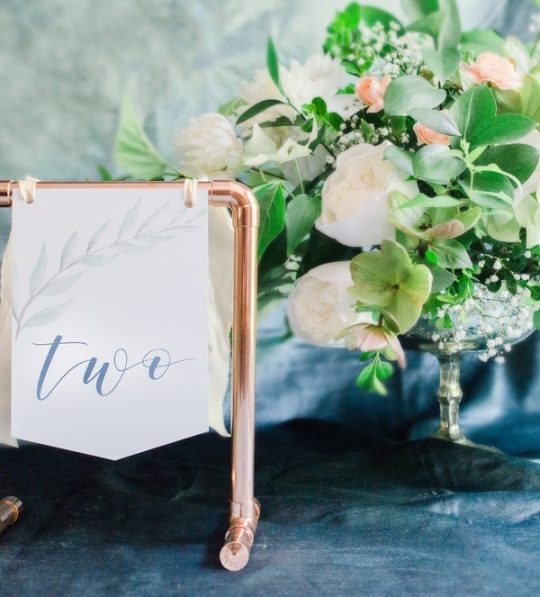
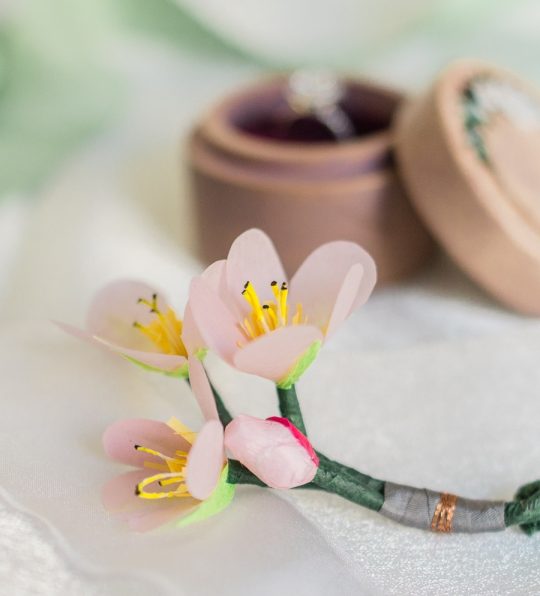
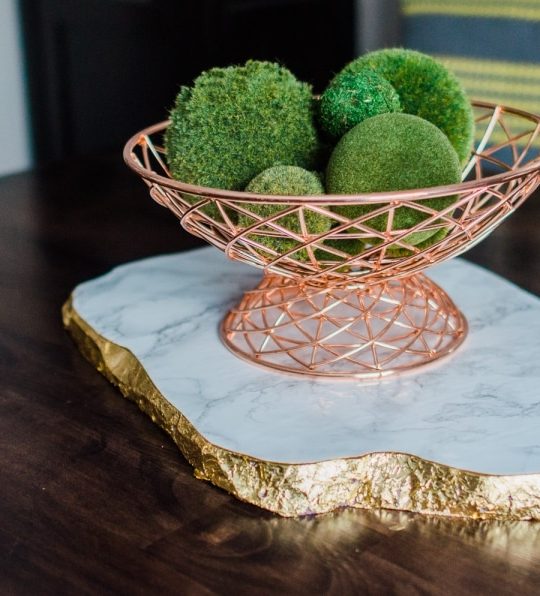
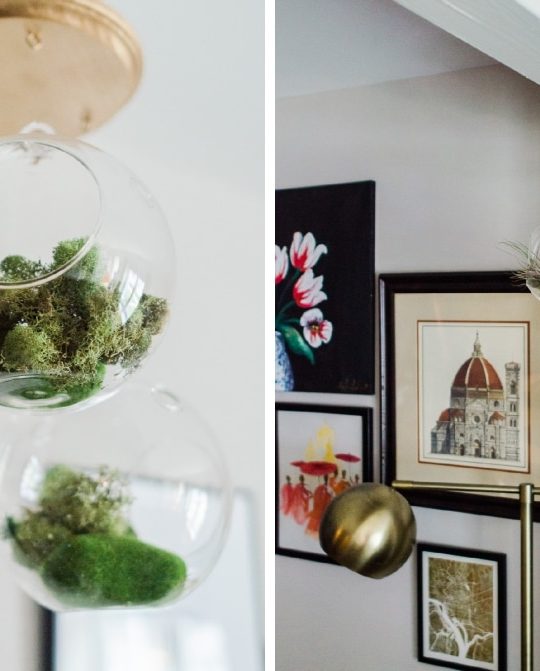
1 comment